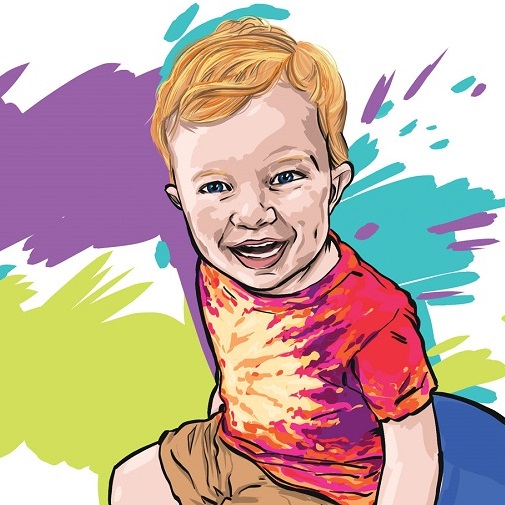RSV No More

July 30, 2019
By the time they have their second or third child, many parents stress far less about every little sniffle. Mothers and fathers learn that babies are resilient, and all of their worry is usually for nothing. That’s why Jackie and Todd Frazier, third baseman for the New York Mets, weren’t overwhelmed with worry when their third child, Grant, began displaying symptoms of a nasty cold at only 5 weeks old.
At the same time, the Fraziers’ other two children, Blake, 5, and Kylie, 3, had loud barking coughs and seemed to be getting sick. So in the middle of the night, they took all three kids to the Pediatric Emergency Department at K. Hovnanian Children’s Hospital at Jersey Shore University Medical Center. The bad news: The older two had croup. But the good news: Grant’s test for Respiratory Syncytial Virus, commonly known as RSV, came back negative.
A few days later, though, Grant still didn’t seem right. “Once he was coughing, congested, lethargic and just not himself, it was time to make a move,” Jackie says.
Since it was New Year’s weekend, and the Fraziers’ primary care doctor was closed, they took Grant back to The Children’s Hospital.
Jackie delivered Grant at Jersey Shore on November 23, 2018, with Angela Jones, M.D., of Healthy Women OB/GYN. It was the first time the Fraziers experienced the labor and delivery unit at Jersey Shore. “I was taken aback by how welcoming and comfortable everyone made us feel when we arrived for his birth. I had a great medical team!” Jackie says. “So when Grant needed to be seen, there was no hesitation on where we would take him.”
Not long after his arrival at The Children’s Hospital, Grant’s second test for RSV came back positive. RSV is the most common cause of bronchiolitis (inflammation of the small airways in the lungs) and pneumonia (infection of the lungs) in children under 1 year of age, according to the Centers for Disease Control and Prevention (CDC). Extremely contagious, RSV usually causes mild respiratory illness and minor cold-like symptoms, but it can be serious in infants and older adults. Some people recover within a week or two, while others require hospitalization. In fact, more than 57,000 children younger than 5 years old are hospitalized in the United States each year due to RSV infection, according to the CDC.
The Pediatric Emergency Department team treated Grant, who weighed 10 pounds, with deep nasal suction, back compressions and nebulizer treatments. He was sick but stable.
Frightening Turn of Events
In many RSV cases, patients get worse before they improve, says Andrew McInnes, M.D., a board-certified pediatric critical care medicine physician at The Children’s Hospital who treated Grant. “But parents shouldn’t look at getting sicker as a failure of care; it’s just the natural evolution of the illness,” he says.
In Grant’s case, somewhere between days three and five, his condition started to worsen, as doctors said it might. Nurses were coming into his room sometimes twice an hour to suction his clogged airways. When Grant started having trouble breathing despite treatments, his doctors decided it was time to move him to the pediatric intensive care unit (PICU).
“My husband and I were just so scared and upset,” Jackie says. “By the third kid, you think you’d know how to handle it, but we had never experienced anything like this. Each day just brought more bad news, and he just kept getting sicker and sicker.”
But the incredible care Grant received in the PICU actually gave Jackie and Todd a moment to breathe.
“Doctors and nurses were with him around the clock,” Jackie says. “They were really listening to his cues and monitoring every tiny change. They were so informative and kept us posted every step of the way.”
Though Grant was at his sickest, Jackie was so confident in her son’s care team that she was able to sleep in his hospital room for the first time in days. Todd, who’d been home with their other two kids, came to see Grant every day.
“Todd would drive Blake and Kylie to the hospital, and I would run out when he got there to take the kids back home as he stayed with Grant,” Jackie says. “The most important thing to us was that Grant was never alone.”
Once in the PICU, in addition to the deep suctioning, Grant was treated with a non-invasive device that warms and humidifies high-flow oxygen therapy through a nasal tube. The warmth and high humidity make receiving oxygen far more tolerable than traditional forced oxygen, which can be too cold, too dry and too forceful for comfort in babies.
“We know that giving young babies more oxygen than they need can have detrimental effects,” Dr. McInnes says. “With this device, we can ensure they’re getting exactly what they need.”
Before this type of therapy was available, doctors at The Children’s Hospital had to insert a breathing tube in RSV patients. But now, Dr. McInnes says, they have decreased their intubation rate at least 50 percent.
“The challenge with intubation is the tube is uncomfortable and can cause patients to feel like they’re gagging, and we want to avoid it if we can,” Dr. McInnes says.
While receiving the high-flow oxygen therapy, Grant was able to breathe better, he was able to sleep and he even happily received expressed breast milk through a feeding tube. Only a few days into his PICU stay, Grant showed signs of improvement. His oxygen levels were good, his chest X-rays were clear and he was able to nurse on his own. After 10 days in the hospital, Grant was released.
There was only one problem: The Fraziers were terrified to take him home.
“We were so grateful that we could leave, but we didn’t want to take him away from all the constant care he’d been getting,” Jackie says. “Those first few nights at home, I didn’t sleep much; I just constantly watched him.”
Close Care Continues

In some patients, RSV can have long-term effects, including allergies, eczema, acid reflux, asthma and other respiratory issues. Grant has all of them except eczema.
The Fraziers are currently working with pediatric pulmonologist Charles Dadzie, M.D., to create a comprehensive care plan for their son. With Dr. Dadzie’s help, the Fraziers have come up with an emergency treatment plan and are tracking what triggers Grant’s respiratory problems.
“It’s so sad that we’re still dealing with the aftermath of RSV,” Jackie says. “He’s spent at least half of each month sick since he’s been home.”
Grant is now 7 months old and on a daily treatment plan that includes a nebulized steroid for his asthma and a no-soy organic goat's milk formula for his allergies and reflux. This recipe seems to be working.
Though he’s still not out of the woods, Dr. Dadzie and Dr. McInnes are hopeful that little Grant will make a full recovery and go on to live a healthy, happy life.
And no matter how many children they have, what more could a parent want?
Next Steps & Resources
- Meet your sources: Angela Jones, M.D., Andrew McInnes, M.D., and Charles Dadzie, M.D.
- To make an appointment with Angela Jones, M.D., Andrew McInnes, M.D., Charles Dadzie, M.D. or another provider, call 800-822-8905 or visit our website
The material provided through HealthU is intended to be used as general information only and should not replace the advice of your physician. Always consult your physician for individual care.
Find a doctor near me
Is an Irregular Heartbeat Normal?

Most children diagnosed with an irregular heartbeat are found to have conditions that are normal and harmless.
How to Care for a Child With a Seizure Disorder

Learn how to care for a child with a seizure disorder. Dr. Sultan offers expert advice on medication, seizure safety, and triggers. Help your child thrive.
Find a doctor near me

3-Year-Old Ball Of Energy Now Seizure-Free
Seizure-free 3-year-old: Learn how doctors at K. Hovnanian Children's Hospital helped Braydin. Find pediatric neurology specialists. Call 800-822-8905.

My Story About Taking My Daughter to the Emergency Room – Laurajean
Pediatric ER visit story. Laurajean shares her daughter's fall experience, emphasizing excellent care received despite COVID-19 concerns. Find care now.

My Story About Taking My Kids to the ER During COVID – Danielle
Danielle shares her positive ER experience during COVID. Learn how Sanzari Children's Hospital provided safe, smooth care for her kids. Call 800-822-8905 for care.

From the NICU to Thriving at Home
NICU to thriving at home: Owen's story at Pascack Valley Medical Center and Hackensack University Medical Center. Learn how expert care helped. Call 800-822-8905.
